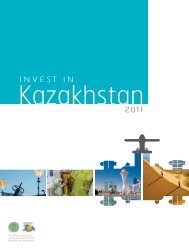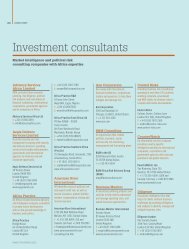NIGERIA Invest in 2012-13 - Newsdesk Media
NIGERIA Invest in 2012-13 - Newsdesk Media
NIGERIA Invest in 2012-13 - Newsdesk Media
Create successful ePaper yourself
Turn your PDF publications into a flip-book with our unique Google optimized e-Paper software.
150<br />
agriculture and water<br />
sesame and cashew,” Mathur said. “We are closely aligned<br />
with the Nigerian government’s efforts to develop local<br />
content and capacity <strong>in</strong> rice production and mill<strong>in</strong>g, and<br />
<strong>in</strong> particular to address the grow<strong>in</strong>g level of imports to help<br />
tackle issues of food security.”<br />
The relative underdevelopment of the country’s<br />
agricultural resources and the fragmentation of its producers<br />
meant that the company, listed <strong>in</strong> S<strong>in</strong>gapore, saw that<br />
<strong>in</strong>vestment <strong>in</strong> the right areas would reap returns.<br />
“Nigeria is endowed with natural resources like fertile<br />
soil, perennial water supply through various rivers and climatic<br />
conditions that are suitable for a range of tropical crops, yet<br />
the yield of most crops is significantly below global averages<br />
and could be doubled <strong>in</strong> output before they even reach the<br />
average global productivity levels – so there is high potential<br />
for improvement,” Mathur says.<br />
“Olam’s bus<strong>in</strong>ess is built on susta<strong>in</strong>able supply cha<strong>in</strong>s,<br />
one crucial aspect of which is develop<strong>in</strong>g close relationships<br />
with farmers. These relationships enable us to identify areas<br />
where we can contribute towards improv<strong>in</strong>g yields, while<br />
mak<strong>in</strong>g the farm<strong>in</strong>g more susta<strong>in</strong>able. Therefore, <strong>in</strong>vest<strong>in</strong>g <strong>in</strong><br />
Nigeria is a good strategic fit.”<br />
2000<br />
2001<br />
2002<br />
2003<br />
2004<br />
2005<br />
2006<br />
2007<br />
2008<br />
2009<br />
2010<br />
source: World Bank<br />
<strong>in</strong>vest <strong>in</strong> nigeria <strong>2012</strong>-<strong>13</strong><br />
1,171.4<br />
1,233.5<br />
1,255.2<br />
1,308.8<br />
1,372.8<br />
1,421.6<br />
1,507.4<br />
1,399.8<br />
1,598.4<br />
1,528<br />
1,4<strong>13</strong><br />
The company is work<strong>in</strong>g with research <strong>in</strong>stitutes,<br />
<strong>in</strong>clud<strong>in</strong>g the International Institute of Tropical Agriculture<br />
(IITA) and with <strong>in</strong>ternational development agencies, <strong>in</strong>clud<strong>in</strong>g<br />
the United States Agency for International Development<br />
(USAID) and the UK’s Department for International<br />
Development (DFID), <strong>in</strong> order to offer smaller farmers<br />
extension services, tra<strong>in</strong><strong>in</strong>g and seeds at concessionary rates<br />
to help to <strong>in</strong>crease their outputs.<br />
Nigeria’s physical size means that it straddles a number<br />
of climatic zones, and has the potential to develop cash<br />
crops currently dom<strong>in</strong>ated by its regional neighbours.<br />
Cote d’Ivoire rema<strong>in</strong>s one of the world’s largest producers<br />
of cocoa for the <strong>in</strong>ternational market and, along with<br />
Gu<strong>in</strong>ea, exports significant volumes of cashew nuts, while<br />
Ghana has a thriv<strong>in</strong>g fruit sector.<br />
The river deltas, synonymous with the oil <strong>in</strong>dustry, are<br />
fertile ground for rice production. Rice consumption is grow<strong>in</strong>g<br />
<strong>in</strong> the region, and with <strong>in</strong>vestments <strong>in</strong> mill<strong>in</strong>g facilities<br />
creat<strong>in</strong>g process<strong>in</strong>g hubs, the potential to supply West Africa<br />
with gra<strong>in</strong> is huge. The country produces around 3.5-4.5<br />
million tonnes of rice per year <strong>in</strong> its current unstructured state,<br />
import<strong>in</strong>g as much as 500,000 tonnes annually to meet the<br />
33.02%<br />
Arable land<br />
Nigeria’s cereal yield (kg per hectare)<br />
910,768 sq km<br />
Total land<br />
3.14%<br />
Permanent crops land<br />
63.84%<br />
Other<br />
As of 2005, source: CIA Factbook







